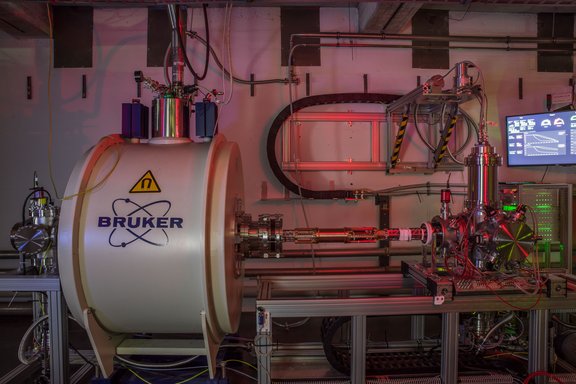The dramatic increase in precision in recent Penning-trap experiments is driving the need for ever-improving cooling techniques. The ELCOTRAP experiment is dedicated to realizing and testing a new cooling technique in which single highly charged ions or protons/antiprotons can be cooled to temperatures corresponding to motional quantum numbers ranging down to orders of 10. The extremely low expected temperatures open up an exciting new frontier of measurements on atomic masses or g-factors, including probing of CPT symmetry, tests of the standard model and QED and the determination of fundamental constants.
The cooling medium used in this technique is provided by a cloud of electrons stored in a dedicated Penning trap: The rapid oscillating cyclotron motion of electrons in a strong magnetic field exhibits spontaneous emission of photons that is only counteracted by the black-body photons of its environment (usually cooled to 4 K), resulting in a mean cyclotron quantum number of ~1 at thermal equilibrium.
Irridiating millimeter-waves at a characteristic frequency in order to drive the motional sideband of the electron's cyclotron and axial motion effectively leads to a thermalization of the axial motion to the same level of mean occupancy of black body photons.
Finally, the axial motion of the electrons are coupled to the cyclotron motion of an arbitrary particle in a spatially distant Penning trap using image currents induced in their respective trap electrodes as a mediating medium. This is made possible by tuning the electron's axial frequency to the constant cyclotron frequency of the particle of interested by varying the trapping voltage of the electron trap.
In order to tackle the technical challenges involved in the ELCOTRAP project, the experiment was specifically designed to support a modular and iterative development workflow. The setup can be split into an "experiment platform", which provides all common features of a Penning-trap experiment, and a modular "experiment chamber", which contains the actual Penning-trap setup and electronics that can be designed specifically for the task at hand.
The experiment platform is centered around a superconducting magnet with a field strength of 7 T, whose horizontal bore enables the experiment to be easily inserted/extracted from the magnet using linear rails.
The inner experimental chamber is cooled to 4 K in less than 12 hours via a closed cycle refrigerator and can be warmed up to room temperature in a few hours using built in heaters. Combining this with a hardware design that is specifically tailored for quick access to the experimental chamber enables very fast turn-around times.
A newly developed thermal joint automatically breaks connection of the heat-shield and thus allows for direct access to the 4 K stage without the need for further disassembly of intermediate stages.
Due to its modular design, the ELCOTRAP platform has also already proven to be a valuable general purpose test-bench for device/electronics characterization in a cryogenic and high magnetic field environment.
Phase I
The first experimental phase was dedicated for general tests of the experiment platform and a precise characterization of the magnetic field. It featured a single five-pole Penning trap with an integrated electron beam ion source, which was successfully used to produce oxygen and carbon ions up to a charge state of +6.
Phase II
The second phase features a highly specialized electron trap that is designed to act as a resonant cavity at millimeter-wave frequencies in order to facilitate the drive of the electron motional sideband. The goal is to characterize the millimeter-wave incoupling and a mechanical cavity tuning mechanism and ultimately to benchmark the axial-cyclotron coupling rate and final particle temperatures.
Phase III
In the third phase, the electron trap from phase II is combined with an optimized ion-coupling trap in order to benchmark and optimize the coupling rate between a single highly charged ion and the electrons.

